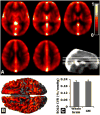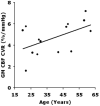Cerebrovascular reactivity measured with arterial spin labeling and blood oxygen level dependent techniques
- PMID: 25708263
- PMCID: PMC4426232
- DOI: 10.1016/j.mri.2015.02.018
Cerebrovascular reactivity measured with arterial spin labeling and blood oxygen level dependent techniques
Abstract
Purpose: To compare cerebrovascular reactivity (CVR) quantified with pseudo-continuous arterial spin labeling (pCASL) and blood oxygen level dependent (BOLD) fMRI techniques.
Materials and methods: Sixteen healthy volunteers (age: 37.8±14.3years; 6 women and 10 men; education attainment: 17±2.1years) were recruited and completed a 5% CO2 gas-mixture breathing paradigm at 3T field strength. ASL and BOLD images were acquired for CVR determination assuming that mild hypercapnia does not affect the cerebral metabolic rate of oxygen. Both CVR quantifications were derived as the ratio of the fractional cerebral blood flow (CBF) or BOLD signal change over the change in end-tidal CO2 pressure.
Results: The absolute CBF, BOLD and CVR measures were consistent with literature values. CBF derived CVR was 5.11±0.87%/mmHg in gray matter (GM) and 4.64±0.37%/mmHg in parenchyma. BOLD CVR was 0.23±0.04%/mmHg and 0.22±0.04%/mmHg for GM and parenchyma respectively. The most significant correlations between BOLD and CBF-based CVRs were also in GM structures, with greater vascular response in occipital cortex than in frontal and parietal lobes (6.8%/mmHg versus 4.5%/mmHg, 50% greater). Parenchymal BOLD CVR correlated significantly with the fractional change in CBF in response to hypercapnia (r=0.61, P=0.01), suggesting the BOLD response to be significantly flow driven. GM CBF decreased with age in room air (-5.58mL/100g/min per decade for GM; r=-0.51, P=0.05), but there was no association of CBF with age during hypercapnia. A trend toward increased pCASL CVR with age was observed, scaling as 0.64%/mmHg per decade for GM.
Conclusion: Consistent with previously reported CVR values, our results suggest that BOLD and CBF CVR techniques are complementary to each other in evaluating neuronal and vascular underpinning of hemodynamic processes.
Keywords: Arterial spin labeling; BOLD; Cerebral blood flow; Cerebrovascular reactivity; Hypercapnia-based fMRI calibration; Neurovascular coupling.
Copyright © 2015 Elsevier Inc. All rights reserved.
Figures









Similar articles
-
Comparison of pulsed and pseudocontinuous arterial spin-labeling for measuring CO2 -induced cerebrovascular reactivity.J Magn Reson Imaging. 2012 Aug;36(2):312-21. doi: 10.1002/jmri.23658. Epub 2012 Apr 27. J Magn Reson Imaging. 2012. PMID: 22544711
-
Test-retest reliability of cerebral blood flow and blood oxygenation level-dependent responses to hypercapnia and hyperoxia using dual-echo pseudo-continuous arterial spin labeling and step changes in the fractional composition of inspired gases.J Magn Reson Imaging. 2015 Oct;42(4):1144-57. doi: 10.1002/jmri.24878. Epub 2015 Mar 6. J Magn Reson Imaging. 2015. PMID: 25752936 Clinical Trial.
-
Assessing cerebrovascular reactivity (CVR) in rhesus macaques (Macaca mulatta) using a hypercapnic challenge and pseudo-continuous arterial spin labeling (pCASL).Neuroimage. 2024 Jan;285:120491. doi: 10.1016/j.neuroimage.2023.120491. Epub 2023 Dec 7. Neuroimage. 2024. PMID: 38070839 Free PMC article.
-
Cerebrovascular reactivity (CVR) MRI with CO2 challenge: A technical review.Neuroimage. 2019 Feb 15;187:104-115. doi: 10.1016/j.neuroimage.2018.03.047. Epub 2018 Mar 21. Neuroimage. 2019. PMID: 29574034 Free PMC article. Review.
-
Non-BOLD contrast for laminar fMRI in humans: CBF, CBV, and CMRO2.Neuroimage. 2019 Aug 15;197:742-760. doi: 10.1016/j.neuroimage.2017.07.041. Epub 2017 Jul 20. Neuroimage. 2019. PMID: 28736310 Review.
Cited by
-
Changes in Prefrontal Gamma-Aminobutyric Acid and Perfusion After the Computerized Relaxation Training in Women With Psychological Distress: A Preliminary Report.Front Psychol. 2021 Apr 13;12:569113. doi: 10.3389/fpsyg.2021.569113. eCollection 2021. Front Psychol. 2021. PMID: 33927662 Free PMC article.
-
Cerebrovascular Reactivity during Prolonged Breath-Hold in Experienced Freedivers.AJNR Am J Neuroradiol. 2018 Oct;39(10):1839-1847. doi: 10.3174/ajnr.A5790. Epub 2018 Sep 20. AJNR Am J Neuroradiol. 2018. PMID: 30237299 Free PMC article.
-
Breath-Hold Induced Cerebrovascular Reactivity Measurements Using Optimized Pseudocontinuous Arterial Spin Labeling.Front Physiol. 2021 Feb 17;12:621720. doi: 10.3389/fphys.2021.621720. eCollection 2021. Front Physiol. 2021. PMID: 33679436 Free PMC article.
-
Comparison of simultaneous arterial spin labeling MRI and 15O-H2O PET measurements of regional cerebral blood flow in rest and altered perfusion states.J Cereb Blood Flow Metab. 2020 Aug;40(8):1621-1633. doi: 10.1177/0271678X19874643. Epub 2019 Sep 9. J Cereb Blood Flow Metab. 2020. PMID: 31500521 Free PMC article.
-
Problems and solutions in quantifying cerebrovascular reactivity using BOLD-MRI.Imaging Neurosci (Camb). 2025 May 2;3:imag_a_00556. doi: 10.1162/imag_a_00556. eCollection 2025. Imaging Neurosci (Camb). 2025. PMID: 40800793 Free PMC article.
References
-
- Fülesdi B, Limburg M, Bereczki D. Cerebrovascular reactivity and reserve capacity in type II diabetes mellitus. J Diabetes Complications. 1999;13:191–199. - PubMed
-
- Spano VR, Mandell DM, Poublanc J, Sam K, Battisti-Charbonney A, Pucci O, et al. CO2 blood oxygen level-dependent MR mapping of cerebrovascular reserve in a clinical population: safety, tolerability, and technical feasibility. Radiology. 2013 Feb;266:592–8. - PubMed
-
- Yonas H, Smith HA, Durham SR, Pentheny SL, Johnson DW. Increased stroke risk predicted by compromised cerebral blood flow reactivity. J Neurosurg. 1993;79:483–489. - PubMed
-
- Rostrup E, Larsson HB, Toft PB, Garde K, Thomsen C, Ring P, et al. Functional MRI of CO2 induced increase in cerebral perfusion. NMR Biomed. 1994;7:29–34. - PubMed
-
- Rostrup E, Law I, Blinkenberg M, Larsson HBW, Born AP, Hom S, et al. Regional differences in the CBF and BOLD responses to hypercapnia: A combined PET and fMRI study. Neuroimage. 2000;11:87–97. - PubMed
Publication types
MeSH terms
Substances
Grants and funding
LinkOut - more resources
Full Text Sources
Other Literature Sources
Medical

